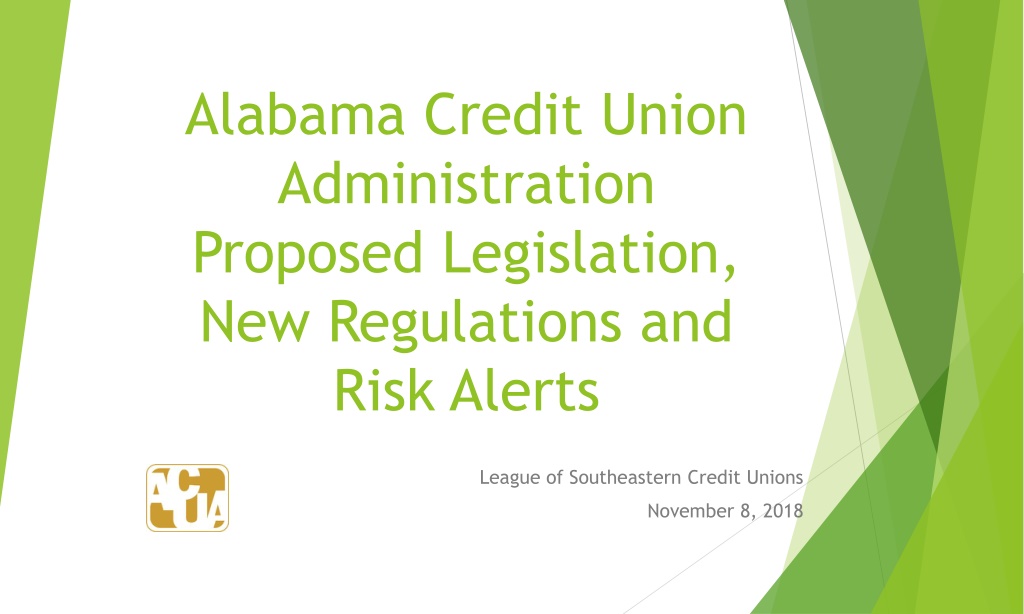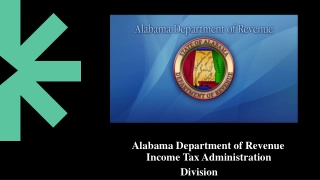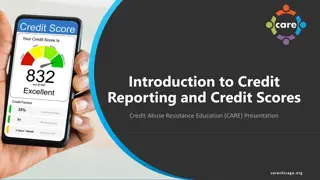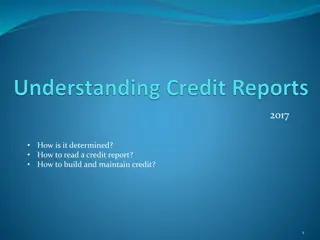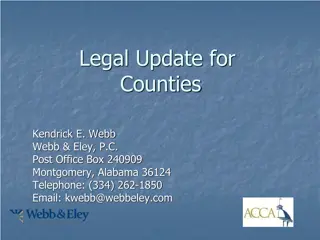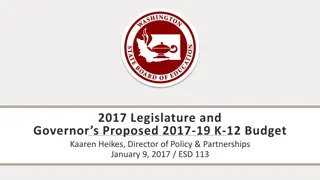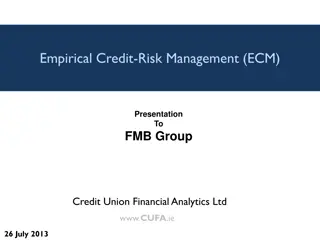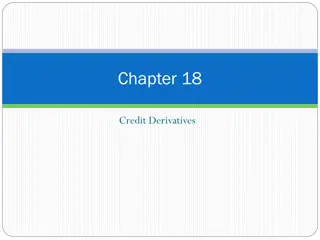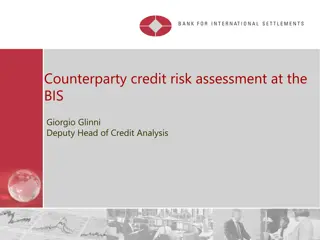Proposed Legislative and Regulatory Changes in Alabama Credit Union Administration
This document outlines proposed statutory changes and recently enacted regulatory changes in the Alabama Credit Union Administration. The proposals include allowing one guest per director on credit union business, adjusting notification timeframes for member meetings, enabling elected officials to serve on the ACUA board, and more. The enacted changes focus on expanding field of membership criteria, procedural requirements for confidential reports, appraisal regulation updates, and corporate governance principles.
Download Presentation

Please find below an Image/Link to download the presentation.
The content on the website is provided AS IS for your information and personal use only. It may not be sold, licensed, or shared on other websites without obtaining consent from the author. Download presentation by click this link. If you encounter any issues during the download, it is possible that the publisher has removed the file from their server.
E N D
Presentation Transcript
Alabama Credit Union Administration Proposed Legislation, New Regulations and Risk Alerts League of Southeastern Credit Unions November 8, 2018
Proposed Statutory Changes to Credit Union Code 2019 Legislative Session Allow one guest per director and committee member to accompany such director or committee member on credit union business without tripping the no compensation statute. Mirror NCUA time frame on notifications to members of a meeting to vote on a merger. Current law is 15 days advance notice; NCUA regulation requires 45 days notice and no more than 90 days notice in advance of the meeting to vote on the merger. Allow elected officials of state chartered credit unions to serve as ACUA Board members in addition to CEO/ President. Enable ACUA Board to appoint NCUA as a conservator of a credit union rather than an agent of ACUA. Specifically addresses regulatory net worth or capital management and composition in the parity provision relating to federal charters. 2
Recently Enacted Regulatory Changes Amend Well-Defined Area to include areas contiguous to existing field of membership in recognition of increased electronic services and fewer in person branch transactions. Establish procedural requirements for Confidential Regulatory Reports and Communications in order to comply with Ala. Code 5-17-60 and Federal Credit Union Act 12 C.F.R. 792.01 et seq. (Touhy regulations). Delete Section 10 of Regulations regarding ACUA board as it is not in compliance with State law regarding open meetings act, participation in meetings electronically, etc. ACUA Board only. 3
Recently Enacted Regulatory Changes Cleaned up appraisal regulation, Section 2, Part 1 Increased appraisal requirement from $150,000 to $250,000 for real estate loans; Added that the policy must comply with FIRREA Real estate loans less than $250,000 must have written estimate value and collateral by qualified individual or firm. For charter conversions, deleted requirement for a legal opinion on articles of incorporation and bylaws complying with Ala. Code Section 5, Title 17. 4
Board and Supervisory Committee Leadership Above all have personal integrity Fiduciary Responsibility Elected by the membership to serve members interests. Defined as: the highest standard of care; trust and confidence to manage and protect property or money; duty to act in the best interest of another party. A person acting in a fiduciary capacity is held to a high standard of honesty and full disclosure in regard to the principal and must not obtain a personal benefit at the expense of the client(member). Board has the duty over general management of the affairs of the credit union particularly: Interest rates, surety bond, dividends, bylaws, and policies 6
Board and Supervisory Committee Leadership Boards typically hire a CEO or manager of the credit union. The Board must ensure that the CEO is qualified to manage the credit union. The Board must delegate the day to day responsibilities to the CEO but must maintain oversight over the affairs of the credit union. Board and committee members in Alabama are not compensated, which allows liability and indemnification of officers, directors, trustees, and members of the governing body of a credit union to be the same as provided for a nonprofit corporation in Title 10A except for willful violations of this title. Individual Board members and Supervisory Committee members do not have authority to act or direct any employees of the credit union without written authority from the Board or the Supervisory Committee. The full Board and full Supervisory Committee have authority but not individual members. Board and Supervisory Committee members should not get involved in the day to day operations of the credit union or get involved individually in member issues. All issues should be brought to the full Board or Committee and should be discussed at that level. 7
Board and Supervisory Committee Leadership Be familiar with the Community in which you operate. Know who your stakeholders are and how to address those stakeholders. Stakeholders in your credit union include but are not limited to: Members Regulators Consumers who may be members Competitors Vendors League Bankers Plaintiffs Know that all complaints or issues are not brought up by individuals who want the credit union to be successful. Use sound business judgement to discern what are true issues and what are not. Avoid conflicts of interest. 8
Board Leadership Establish appetite for risk Select qualified manager/CEO and monitor his or her performance Establish business strategies and policies Monitor exceptions to Board approved policies Monitor compliance with laws, regulations and adhere to regulatory reports, orders and agreements Do not allow preferential treatment of directors, committee members, employees or family members of those groups Maintain independence from management Exercise independent thinking, obtain full information and apply to decision making 9
Supervisory Committee Supervisory Committee serves as an audit function and a check and balance for the credit union members Supervisory Committee must be independent of the Board and management and think independently Supervisory Committee may remove a Board member Supervisory Committee must oversee the Board to ensure that the Board members are acting in the best interests of the credit union members and not themselves Responsible for comprehensive annual audit must submit to the Board and to the members annually Responsible for account verification at least every two years 10
Supervisory Committee May suspend any officer, director or member of any committee of the credit union Powers should not be exercised without valid causes for action Supervisory Committee should ensure that the Board and management correct deficiencies in examination reports and all third party reports No individual member should act with the full Committee delegation of authority Representative of the Supervisory Committee should attend all Board meetings and should report on the activities of the Committee Committee may hire third parties to perform duties but may not delegate the responsibilities of the Committee Board should ask the Committee to review areas of concern 11
Supervisory Committee Considerations Interim audits are an important part of the Supervisory Committee s oversight and monitoring credit union operations. Audits should include, at a minimum: General ledger account reconciliations for material/high transaction volume accounts. (Example: Bank and Corporate account reconciliations); Review of new loan products (Example: Indirect Lending) for compliance with Board approved lending policies; and Remediation of material regulator Findings and Documents of Resolution. 12
Key Monitoring Tools and Indicators that All Boards Should Monitor Internal reports: financial statements, past dues, allowance analysis, investment activity, interest rate risk models, insider transactions, overdrafts, compliance tracking reports, exception reports, file maintenance reports External Reports: Reports of Examination, regulatory letters, regulatory orders, audit reports and letters to management, other third party reports, etc. Higher than average loan growth higher than historical or higher than peer in the same period Concentrations of credit risk board should establish risk tolerances and monitor for compliance with board approved risk appetite. Policy exceptions should be presented to the board for review and a determination of approval or disapproval. Receive reports from Supervisory Committee or its delegate on the Committee s activities including loan underwriting exceptions Monitor all delinquent loan categories not just reportable delinquencies and trends 13
Key Monitoring Tools and Indicators that All Boards Should Monitor Past dues 30 59 days File maintenance reports Allowance for loan losses (detail, trends, versus past dues, charge offs, etc.) Liquidity and net worth adequacy must be monitored monthly against restraints and goals Interest rate risk management: NIM, rates on new loan production and deposit accounts, profitability forecasts and ALM modeling in up and down rate environments Lender incentive plans You get what you pay for. Operating expenses especially discretionary expenses (fiduciary responsibility to members) 14
Corporate Governance Health Checklist Is the Board performing an evaluation of themselves? Does the Board have goals and metrics by which to evaluate the Board performance? Does the Board review the mission statement of the credit union annually? Do the members of the Board reflect the member base of the credit union, specifically race, gender, age, employer (particularly for SEG groups)? Are Board members rewarding themselves through international or luxury training trips or other perks not available to other members of the credit union? Are committees, other than Supervisory Committee, acting with specific authority from the board? 15
Corporate Governance Health Checklist Are committee minutes included in Board packages each month? Are committee chairs reporting substantive information to the Board? If there is a no report from a committee chair, why? Do the bylaws contain term limits for Board members and Supervisory Committee members? Do the bylaws contain an age limit in order to run for another term of office? Is the Board actively soliciting and recruiting new Board and committee members to run for office? Are the bylaws of the credit union up to date with laws and regulations? 16
Corporate Governance Health Checklist Is the Supervisory Committee actively engaged in audits of the activities of the credit union? Is the Supervisory Committee serving as a check on the Board of Directors? Are the Board and Supervisory committee reviewing items in enough detail to be an independent check on management? Does the Board have a strong conflict of interest policy? Is the policy being adhered to and who is checking to ensure that the policy is adhered to? Do Board and Supervisory Committee members maintain their personal finances in good order? 17
Alabama State-Chartered Credit Unions Selected Financial Information 18
Key Stats for Alabama State-Chartered Credit Unions, excluding the corporate credit union As of and ytd 6/30/18 Annualized For the year ended 12/31/17 Total Assets $12,739,219,886 $12,375,310,272 Increase 5.88% 3.94% Return on Average Assets 0.78% 0.72% Total Loan Growth 11.47% 6.22% New Vehicle Loan Growth 29.0% 20.0% Used Vehicle Loan Growth 18.0% 4.0% Share and Deposit Growth 6.31% 3.70% Net Worth Growth 6.70% 6.71% Net Worth Ratio 11.90% 11.86% Member Growth 4.13% 0.41% 19
Key Stats for Alabama State-Chartered Credit Unions, excluding the corporate credit As of and ytd 6/30/18 For the year Annualized ended 12/31/17 Net Int. Margin/Avg. Assets 2.70% 4.23% Provision/AA 0.37% 0.38% Net charge-offs 0.58% 0.72% Operating Expense/AA 3.14% 3.14% Operating Exp/Gross Income 63.21% 64.62% Delinquent Loans/Total Loans 0.82% 0.96% 30-59 Days Delinquent/Total Loans 1.13% 1.79% 20
State Chartered Credit Unions Supplemental Information (excludes Corporate Credit Union) 26
